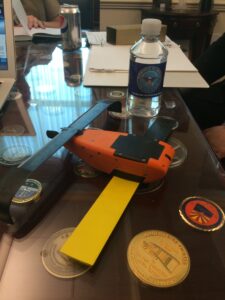Accelerating Innovation By Breaking Up Contracts: SBIR & Beyond
Posted on

ARLINGTON: Innovation is the buzzword of the year. But how do you actually get it? As Pentagon leaders look anxiously over their shoulders at rapidly advancing threats from Russia, China, and beyond, military middle managers are wrestling with the details of how to accelerate the development of new technology. That includes breaking up big contracts with big companies, helping small companies get together with each other and with government sponsors, and finding new ways to use that old standby, the Small Business Innovation Research (SBIR) fund.
“We’ve been pushing on this idea of doing prototyping and experimentation, and you would not believe how hard it was to get actually a fairly small budget,” said Nick Guertin, director of transformation in the Navy’s R&D secretariat. Speaking for himself, not the Navy, to a gathering of entrepreneurs and officials hosted by TandemNSI last month, Guertin said that it was tremendously difficult to get a pot of funding dedicated to exploiting opportunities to do prototypes and experiments as they arose, because it would be updating Congress on exactly what it would be buying as events unfolded, rather than locking in specifics at the time the budget was submitted.
“Wow, that was hard,” recalled Guertin. “Congress, they want to know that they’ve got control. [It’s difficult] understanding that innovation requires speed of thought and speed of action and a two-year time horizon to decide is not speed.”
But there’s tremendous pressure from the Pentagon to quickly explore new ideas that might provide an advantage over potential adversaries. “The Secretary of the Navy, he’s screaming for innovation,” said Capt. John Zimmerman, the deputy command information officer at Naval Sea Systems Command (NAVSEA). The pace of change in cyberspace in particular was forcing the Defense Department to get faster, he told TandemNSI, but acceleration ain’t easy.
“Cyber’s going to help drive it, but….we’re sill struggling,” Zimmerman said. “Right now, we have the fleet commanders screaming for improvements in cyber, [asking], ‘What can you do this year?’ And I’ll tell you, most of the program managers that are answering are like, ummm, ‘I can do something in maybe three years.'”
“It’s mostly due to legacy architectures and hardware that just can’t be that responsive,” Zimmerman said.
An important way around that roadblock is open architecture: systems with published standards for which any vendor can develop plug-and-play components, rather than everything requiring the prime contractor’s proprietary secret sauce. But it’s not enough to have open architecture in the technology: You need it in the structure of programs and contracts.

The Virginia-class attack submarine USS Minnesota under construction in Newport News.
Cracking Contracts Open
“We want to think about what is it we want to build, compose it into modules, business unit modules, so that we can contract for them as pieces,” said Guertin, “instead of taking out big problems and mapping them to a big contract, locking it in to a single vendor, and being stuck forever.”
If your architecture and your mindset are both really open, said Jacob Glassman, systems design manager for the Littoral Combat Ship program, you can contract with innovative small businesses in all sorts of unexpected areas. While you don’t want a nuclear warhead being told to detonate by open source software, he said, even a highly classified system has plenty of mundane functions you can open up to small business competition.
“You think, ‘Oh my god, I’m not even going to touch a nuclear warhead,'” Glassman said. But if you actually look at the system, you’re like, ‘Well, okay, you got the warhead, that’s one piece, granted, you don’t want to mess with that, but I need a planner, and part of that planner needs to tell me to tell me weather patterns. I can’t get a small business to do weather pattern modeling?'”
Open architecture is in play for one highly sensitive area already, Glassman noted: the AN/BYG-1 Combat Control System used on the Navy’s nuclear-powered submarines. That allows small businesses to bring in small updates in a small amount of time, under the umbrella of prime contractor General Dynamics.
“We developed the software development kit and we gave it to the small business, and separate from the prime contractor, they were able to develop a [software] payload,” said Glassman. “A typical integration will take months….It took them 48 hours to get it up and running in the prime contractor’s lab.”
“That’s what the power of open architecture can do,” Glassman said.

The Sikorsky-Boeing SB-1 Defiant concept for the Joint Multi-Role demonstrator, a predecessor to the Future Vertical Lift aircraft.
Collaboration Is Counter-Cultural
The flipside of taking apart and opening up big systems is putting smaller ones together. As computing power doubles every 18 months in accordance with Moore’s Law, for example, it becomes easier and easier to have different functions share the same computing resources, rather than having duplicative dedicated processors. The hard part is getting the bureaucracy to see such opportunities.
“Unfortunately, we manage ourselves as fiefdoms, each program is an island unto itself,” said Guertin. “We tend not to think of ourselves as a team, but as individual program managers with individual authorities and responsibilities.”
Companies also need to collaborate more. One increasingly important forum is open standards groups such as the FACE (Future Airborne Capability Environment) consortium, which is laying the foundations for the common cockpit of the Future Vertical Lift family of aircraft. “It’s a powerful example about how you collaborate together [across] lots of different companies — 80 at last count – to …afford the government the ability to have speed, to have innovation,” Guertin said. “That is unfortunately an isolated example.”
Less formal groups, like TandemNSI itself, can also play a valuable role, said Zimmerman. “I’m excited here about organizations…like TandemNSI” that can help new companies navigate the complicated Pentagon process, he said. “I’ll tell ya, I’m too damn busy” to help every innovator who might deserve it, Zimmerman said. “I might read a white paper or two, but I’m so busy with everything else I got going on, I don’t have the time to take a small business and say, this is how you go and work the Small Business Innovative Research process.”
“I’m a huge fan of SBIR,” Zimmerman said.

Perdix mico-drone on DepSecDef Bob Work’s office table
SBIR & Beyond?
The Small Business Innovation Research program, created in 1982, remains the best pathway for new entrants to get federal funding — but they need to know how to navigate it. Even if your particular product doesn’t make it through the three-step SBIR process to get funded by a particular government program, for example, it still goes into a kind of catalogue. At that point, an entirely different program to decide they want it and restart the process where it left off. In fact, once a particular SBIR topic has been created, government officials can revive it years later and use it to accelerate contracts with entirely different companies from the ones originally involved.
“If a company has been awarded an SBIR contract, even if a phase one that didn’t proceed to phase two, a government sponsor can reach back to that SBIR (for an appropriately similar technical area) as a contracting vehicle, which potentially shaves years off the R&D/developmental contracting timeframe,” said one Naval Sea Systems Command official who attended the TandemNSI event. That said, “Government employees have to write the SBIR topics and they have to compete to get those topics approved and funded,” the official continued, so it’s good for small businesses to get to know key people in acquisition agencies who can get a SBIR topic started in the first place.
“It’s a great thing, unfortunately not as widely used as we would like,” Guertin said of SBIR. But if you don’t have an in through SBIR or some other vehicle, what should your company do? “We don’t have that licked just yet.“
Subscribe to our newsletter
Promotions, new products and sales. Directly to your inbox.
